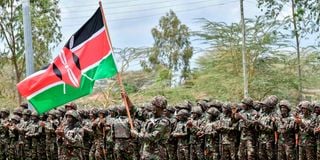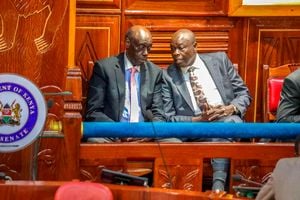Back up military mission in DRC with diplomacy

Kenya Defence Forces (KDF) soldiers attend a flag presentation ceremony by President William Ruto before their deployment to the Democratic Republic of Congo (DRC) as part of the East Africa Community Regional Force (EARDC) at the Embakasi Garrison in Nairobi on November 2, 2022.
As the Kinshasa government struggles to maintain its grip on the eastern parts of the Democratic Republic of Congo (DRC) following a resurgent M23 rebel group assault, Nairobi has offered a helping hand, deploying Kenya Defence Forces (KDF) as part of the East African Community Regional Force (EACRF).
This, indeed, demonstrates that Kenya, just like other EAC members, is committed to helping its newest entrant in the regional bloc to stabilise.
While the deployment of KDF as part of EACRF is welcome, and may in fact help alleviate the suffering of mostly women and children fleeing conflict in eastern DRC, there is a need to broaden the conflict resolution approaches beyond the military engagement, and bring the rebel groups to the negotiating table. Like many others in Africa, the conflict in DRC is unique and complicated by both domestic and foreign drivers.
Firstly, historically, Belgium managed the Congo with brute force. The atrocities meted out on the Congolese by King Leopold II and the assassination of DRC’s first Prime Minister Patrice Lumumba in 1961 point to great foreign interference and the murky ground on which post -independence DRC was built.
Secondly, the 1994 genocide against the Tutsi in Rwanda, and the resultant remnant rebel groups that operate across the border, have greatly destabilised hosts Eastern Congo. While DRC points an accusing finger at Uganda and Rwanda for backing rebel groups on its soil, both neighbours have denied the accusation.
Regional mechanism
Thirdly, peace operations in DRC for the past two decades have borne little or no fruit. The United Nations should, therefore, support the current regional mechanism, but engage more with the local context in pursuit of a political solution as opposed to ad hoc military interventions that are reactive, expensive and meant to simply save lives rather than build sustainable peace.
Fourth, the vast natural and mineral resources in DRC mean the conflict could be resource-based, leading to what is termed “the resource curse”. Consequently, there are several local and global spoilers to the peace processes — those that benefit from the conflict in DRC by extracting minerals unhindered.
To the spoilers, who may include powerful multinational corporations (MNCs), a peaceful DRC may have a negative dynamic to their mineral businesses. Of course, MNCs have also made a positive contribution to the DRC, especially through their corporate social responsibility activities.
As Kenyan boots enter the Congo, the current shuttle diplomacy spearheaded by former President Uhuru Kenyatta and his successor, President William Ruto, is welcome, and it remains to be seen whether it will change the dynamic of the conflict in favour of a political solution.
A peaceful Congo is good not just for Kenya; it will open up the entire African Great Lakes region, by linking the Indian Ocean to the Atlantic. With the proposed Grand Inga dam in DRC expected to meet most of the continent’s energy needs upon completion, and the opportunities under the African Continental Free Trade Area (AfCFTA), a peaceful DRC is, certainly, good for everyone, first for the Congolese and, secondly, for the prosperity of the entire continent.
Dr Kirui teaches history and government at the University of Eldoret. [email protected].





